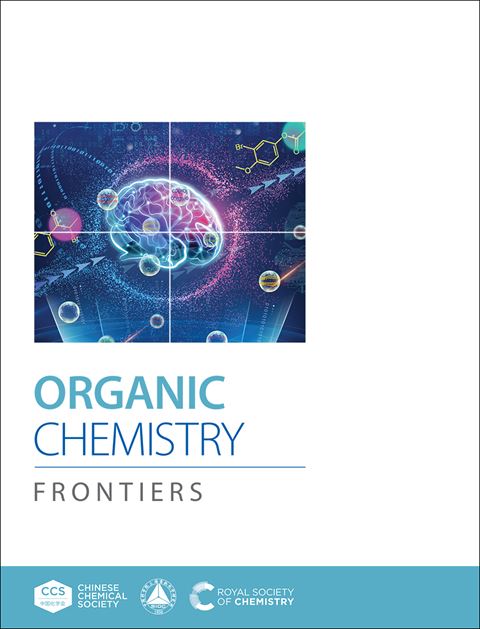两性离子的三重和四重氢键基序
IF 4.6
1区 化学
Q1 CHEMISTRY, ORGANIC
引用次数: 0
摘要
报道了一种易于获取的去氮蝶呤支架的两性离子三键和四键氢键杂环模块。3h键两性离子分子的固态结构揭示了由水、甲醇或氯阴离子组成的各种氢键1D链的形成,这取决于质子化的程度。研究了新设计的两性离子单体AAD和AADA (D =氢键供体,A =氢键受体)在溶液中的结合,以确定互补伙伴并评估结合强度。AAD和AADA基序在加入一半等量的酸后形成3h键二聚体,代表了自然存在的DNA i基序中C-C +对的负电荷模拟物。AADA基序与盐酸的质子化将其转化为非h键形式,其中尿素部分与氯阴离子络合。氯离子与非亲核阴离子的交换解除了尿素基团的旋转,导致与2,7-二氨基-1,8-萘啶形成ADDA-DAAD杂络合物。本文章由计算机程序翻译,如有差异,请以英文原文为准。

Zwitterionic triple- and quadruple hydrogen-bonding motifs
Zwitterionic triple and quadruple hydrogen-bonding heterocyclic modules based on an easily accessible deazapterin scaffold are reported. The solid-state structure of 3H-bonding zwitterionic molecules revealed the formation of various hydrogen-bonded 1D chains composed of water, methanol, or a chloride anion, depending on the extent of protonation. The association of newly designed AAD and AADA (D = hydrogen-bond donor, A = hydrogen-bond acceptor) zwitterionic monomers was studied in solution to identify complementary partners and to evaluate binding strength. Both AAD and AADA motifs form 3H-bonded dimers after the addition of half an equivalent of acid, representing a negatively-charged analogue of the C–C+ pair in naturally occurring DNA i-motifs. The protonation of the AADA motif with hydrochloric acid converts it into a non-H-bonding form where the urea moiety is complexed with the chloride anion. The exchange of chloride with non-nucleophilic anions unlocks the rotation of the urea group, resulting in the formation of the ADDA–DAAD heterocomplex with 2,7-diamido-1,8-naphthyridine.
求助全文
通过发布文献求助,成功后即可免费获取论文全文。
去求助
来源期刊

Organic Chemistry Frontiers
CHEMISTRY, ORGANIC-
CiteScore
7.90
自引率
11.10%
发文量
686
审稿时长
1 months
期刊介绍:
Organic Chemistry Frontiers is an esteemed journal that publishes high-quality research across the field of organic chemistry. It places a significant emphasis on studies that contribute substantially to the field by introducing new or significantly improved protocols and methodologies. The journal covers a wide array of topics which include, but are not limited to, organic synthesis, the development of synthetic methodologies, catalysis, natural products, functional organic materials, supramolecular and macromolecular chemistry, as well as physical and computational organic chemistry.
 求助内容:
求助内容: 应助结果提醒方式:
应助结果提醒方式:


